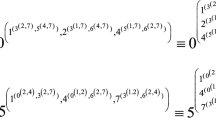Abstract
High-Level Test Synthesis (HLTS), a term introduced in recent years, promises automatic enhancement of testability of a circuit. In this paper we will show how HLTS can achieve higher testability for BIST-oriented test methodologies. Our results show considering testability during high-level synthesis, better testability can be obtained when compared to DFT at low level. Transformation for testability, which allows behavioral modification for testability, is a very powerful HLTS technique.
Similar content being viewed by others
References
P.H. Bardell, W.H. McAnney, and J. Savir, Built-In Test for VLSI: Pseudo-random Techniques, John Wiely & Sons, Inc., New York, 1987.
S. Chiu and C.A. Papachristou, “A Design for Testability Scheme with Applications to Data Path Synthesis,” Proc. ACM/IEEE Design Automation Conference, June 1991, pp. 271–277.
T. Lee, N. Jha, and W. Wolf, “Behavioral Synthesis of Highly Testable Data Paths under the Non-Scan and Partial Scan Environment,” Proc. 30th Design Automation Conf., 1993, pp. 292–297.
M. Abramovici, M. Breuer, and A. Friedman, Digital Systems Testing and Testable Design, IEEE Press, New York, 1990.
K.D. Wagner and S. Dey, “High-Level Synthesis for Testability: A Survey and Perspective,” Proc. 33rd Design Automation Conference, 1996, pp. 131–136.
C. Papachristou, S. Chiu, and H. Harmanani, “A Data Path Synthesis Method for Self-Testable Designs,” Proc. 28th Design Automation Conference, June 1991, pp. 378–384.
L. Avra, “Allocation and Assignment in High-Level Synthesis for Self-Testable Data Paths,” Proceedings of the International Test Conference, 1991, pp. 463–472.
I. Parulkar, S. Gupta, and M. Breuer, “Data Path Allocation for Synthesizing RTL Designs with Low BIST Area Overhead,” Proc. 32nd Design Automation Conference, 1995, pp. 395–401.
C.A. Papachristou and J. Carletta, “Test Synthesis in the Behavioral Domain,” Proc. International Test Conference, Oct. 1995, pp. 693–702.
S. Dey and M. Potkonjak, “Transforming Behavioral Specifications to Facilitate Synthesis of Testable Designs,” Proc. International Test Conference, 1994, pp. 184–193.
Z. Peng and K. Kuchcinski, “Automated Transformation of Algorithms into RTL Implementations,” IEEE Trans. CAD, Vol. 13, pp. 150–165, Feb. 1994.
A. Majumdar, R. Jain, and K. Saluja, “Incorporating Testability Considerations in High-Level Synthesis,” J. Electronic Testing: Theory and Applications, Vol. 5, No. 1, pp. 43–55, Feb. 1994.
H. Harmanani and C.A. Papachristou, “An Improved Method for RTL Synthesis with Testability Tradeoffs,” Proc. ICCAD, Nov. 1993, pp. 30–35.
I.G. Harris and A. Orailoglu, “Microarchitectural Synthesis of VLSI Designs with High Test Concurrency,” Proc.DAC-94, June 1994, pp. 206–211.
I.G. Harris and A. Orailoglu, “SYNCBIST: SYNthesis for Concurrent Built-In Self-Testability,” Proc. ICCD-94, Oct. 1994, pp. 101–104.
M. Vahidi and A. Orailoglu, “Testability Metrics for Synthesis of Self-Testable Designs and Effective Test Plans,” Proceedings of the 13th IEEE VLSI Test Symposium, April 1995, pp. 170–175.
V. Fernandez, P. Sanchez, and E. Villar, “High-Level Synthesis Guided by Testability Measures,” presentation at the First International Test Synthesis Workshop, May 1994.
K. Therling and J. Abraham, “An Easily Computed Functional Level Testability Measure,” Proc. International Test Conference, 1989, pp. 381–390.
V. Chickermane, J. Lee, and J. Patel, “Design for Testability Using Architectural Descriptions,” Proc. International Test Conference, 1992, pp. 752–761.
C. Chen, T. Karnic, and D. Saab, “Structural and Behavioral Synthesis for Testability Techniques,” IEEE Trans. on CAD, Vol. 13, pp. 777–785, June 1994.
M. Gentil, D. Crestani, A. Rhalibi, and C. Durante, “A New High Level Testability Measure: Description and Evaluation,” Proc. VLSI Test Symposium, 1994, pp. 421–426.
C.C. Chuang and A.K. Gupta, “The Analysis of Parallel BIST by the combined Markov Chain(CMC)Model,” Proc. International Test Conference, 1989, pp. 337–343.
M. Baklashov, “Behavioral-Structural Testability Modeling and Synthesis for BIST with Applications to High-Level Synthesis,” Ph.D. dissertation, Case Western Reserve University, Cleveland, Jan. 1997.
K. Lai and C.A. Papachristou, “BIST Testability Enhancement of System Level Circuits: Experience with An Industrial Design,” Proc. Asian Test Symposium, Nov. 1996, pp. 219–224.
Author information
Authors and Affiliations
Rights and permissions
About this article
Cite this article
Papachristou, C.A., Baklashov, M. & Lai, K. High-Level Test Synthesis for Behavioral and Structural Designs. Journal of Electronic Testing 13, 167–188 (1998). https://doi.org/10.1023/A:1008309921888
Issue Date:
DOI: https://doi.org/10.1023/A:1008309921888




